Heart attack warning: Sign in your eyes you may be at risk of life-threatening condition

Heart attack happens when a blockage in a person’s coronary artery causes part of their heart muscle to be starved of blood and oxygen. It is a medical emergency. While the symptoms tend to come on suddenly, such as a pain or discomfort in the chest, there are a number of bodily changes that can signal a person is at a high risk of having one. These include changes in the eyes.
The vein is a lot bigger and dilated
Dimitra Skonda, assistant professor
High blood pressure is a major precursor to cardiovascular complications such as a heart attack. As the NHS explained: “Persistently high blood pressure can put a person’s arteries and heart under extra strain, increasing their risk of a heart attack.” Consistently high blood pressure can reveal itself in the eyes.
According to Dimitra Skonda, MD, PhD, assistant professor of Ophthalmology and Visual Science at the University of Chicago Medicine and a retinal specialist: “The ratio between the size of retinal arteries to veins is supposed to be approximately two to three.
“If you see the artery is a lot smaller than the vein, or the vein is a lot bigger and dilated, that can be evidence of high blood pressure or cardiovascular risk factors.”
The blood vessels in the retina can also become a little more stiff and hardened, according to Dr. William White, an optometrist with Baylor Scott & White Health, a not-for-profit health care system based in Texas.
He said: “When it gets really bad, we’ll see some of the blood vessels start to leak. We will see some haemorrhaging. And that can cause a whole range of vision issues.”
How to prevent a heart attack
Lowering blood pressure will offer a robust defence against having a heart attack. “High blood pressure can often be reduced by a healthy diet, moderating your intake of alcohol, maintaining a healthy weight and taking regular exercise,” explained the NHS.
People should also avoid smoking. Smoking is a major risk factor for heart attacks because it causes atherosclerosis and raises blood pressure, notes the NHS.
Atherosclerosis is a disease in which plaque builds up inside a person’s arteries, plaque hardens and narrows your arteries, this means the heart has to work harder to pump blood around the body, raising the risk of having a heart attack.
What are the symptoms of a heart attack?
According to the British Heart Foundation, heart attack symptoms can vary but the most common signs of a heart attack are:
- Chest pain or discomfort that suddenly occurs and doesn’t go away. It may feel like pressure, squeezing or heaviness in a person’s chest
- Pain that may spread to a person’s left or right arm or may spread to their neck, jaw, back or stomach
- Feeling sick, sweaty, light-headed or short of breath.
Other less common symptoms include:
- A sudden feeling of anxiety that can feel similar to a panic attack
- Excessive coughing or wheezing.
Pain levels can also vary from person to person, says the health site.
The health body said: “For some people the pain or tightness in their chest is severe, while other people just feel uncomfortable, or pain similar to indigestion.”
Heart attack symptoms can persist over days, or they can come on suddenly and unexpectedly, it adds.
As the NHS explains, it’s the overall pattern of symptoms that helps to determine whether a person is having a heart attack.
Source: Read Full Article


